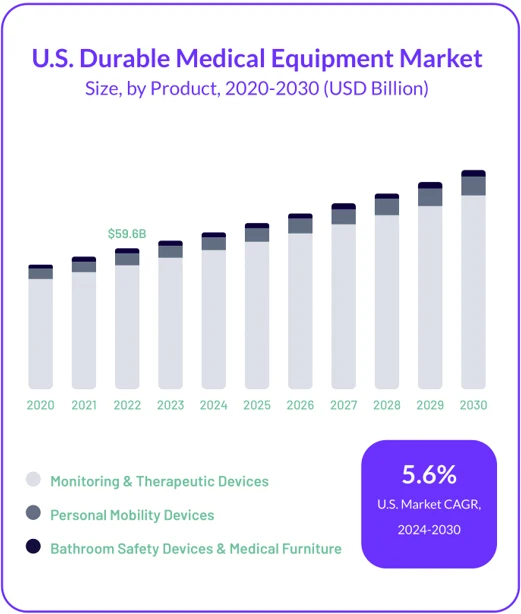(No, we don’t need your email)
The Demand for DME: How Innovative DME Solutions Are Improving Care, Driving Efficiency, And Reducing Costs
Discover the transformative impact of Durable Medical Equipment (DME) management solutions on healthcare efficiency and patient outcomes. This whitepaper by Wynne Systems explores innovative strategies to streamline processes, reduce costs, and enhance the patient experience in an ever-evolving healthcare landscape.
- Current Challenges in DME Management
- Impact on Healthcare Providers
- Innovative Solutions
- Benefits of DME Management Systems
- Future Outlook
Gain comprehensive insights and detailed strategies by downloading the full whitepaper today. Equip your organization with the knowledge to drive efficiency and improve patient outcomes with DME management solutions.

Introduction
Hospitals, health systems, and post-acute care organizations in the U.S. continue to face ever-changing market dynamics and a myriad of challenges that have contributed to the increased economic compression dubbed the “big squeeze.” The aging baby boomer population combined with an increased chronic disease burden are top of mind for organizations and a major driver of the nation’s $4.4T in health expenditures.
Staffing shortages, rising costs for hospital services, equipment and labor, and Medicare payment cuts have threatened many organizations’ viability. For those that provide Durable Medical Equipment (DME) and Home Medical Equipment (HME) to patients, supply chain shortages, compliance demands, and inefficiencies at every turn have added to the pressure cooker of operational and financial challenges. As the shift to value-based care and home health accelerates, innovative solutions that streamline DME processes and drive quality and outcomes will become even more important.
In this white paper, we explore the current challenges of the DME market, the impact on staff and patients, and how organizations can meet ever-increasing demands, and prepare now to scale down the line.
An Inefficient and Costly Process
Fueled by aging, sicker populations and technological advancements, the DME market experienced tremendous growth in recent years and is expected to reach $93B by 2030.

While initiating, transporting, and delivering DME should be as easy as placing an order on Amazon, the reality is that like healthcare itself, the process is fragmented, cumbersome, and complex.
Many moving parts and disparate systems all have to come together within a short period of time, but the process often operates in a silo, with nurses at the helm. Nurses must quickly get a complete understanding of their patients including their conditions, unique needs,
living arrangements, family members and caregivers, and the equipment they will need so care can be delivered in a timely manner.
The journey from placing an order and sending the equipment from the warehouse to a facility or a patient’s home is rife with manual processes and manual labor, as nurses are taxed with coordinating multiple disparate vendors, departments and software systems, and setting up equipment once it’s delivered. Since the names of equipment often vary between vendors, nurses must map parts and product numbers to ensure the right order is placed. Although nurses use their best judgment to determine patients’ needs, incompatible parts orders or missed items are inevitable.
Once an order is placed, nurses often must follow up several times to ensure the equipment will be delivered on time and when they or someone else will be available to accept the delivery. Organizations must also track and maintain equipment and coordinate repairs to ensure it is available and reliable.
Since nurses often lack a centralized system to coordinate DME, inefficiencies that cause errors and multiple requests, waste time, and drive costs are the norm. Instead of taking a proactive approach, organizations often react as needs arise and unnecessarily procure inventory.
$265.6B of annual healthcare waste is due to administrative complexity. Up to $265B annually can be saved due to administrative simplicity.
All of these demands place an undue burden on already overwhelmed nurses, and pull them away from what they do best: deliver care. Nearly half of clinicians say they experience burnout, and within the last 6 months, one-third say they have considered leaving their current roles, one survey found. With mounting pressures each day, it’s no surprise that staffing shortages persist and continue to impact quality of care, outcomes, and the patient experience.
Timely Care Is Necessary to Prevent Hospital Readmissions
Approximately 76% of hospital readmissions are potentially avoidable and associated with $12 billion in Medicare expenditures. Ensuring that patients have access to the right type of equipment in a timely manner is critical to prevent adverse events that lead to hospital readmissions such as those related to chronic obstructive pulmonary disease (COPD) and bronchiectasis. The timeliness factor also ensures that nurses can complete risk assessments, review care plans, ensure medication adherence, and educate patients about follow-up care.
Yet without streamlined solutions, clinicians lack transparency of the status of a delivery and may not be made aware of a problem until the patient is back in the hospital. Plus, the lag time in getting the right equipment can affect the patient experience, leaving patients and their families feeling uncared for, anxious, and stressed.
By 2030, the demand for registered nurses will increase 28% from 2.8 million to 3.6 million.
Navigating the Shift to Home Health
Up to $265 billion worth of care for Medicare Fee-For-Service and Medicare Advantage beneficiaries could shift from traditional facilities to the home by 2025 without a reduction in quality or access. Post-acute care, long-term care, dialysis, and infusion therapy, in particular, are also expected to come together in a more comprehensive way.
With more care moving to the home, healthcare organizations must prepare now with a DME strategy and clinical models and identify partnerships with vendors that can provide flexible solutions and allow organizations to scale.

Innovative, Streamlined Systems Are Transforming DME
While some healthcare organizations have attempted to build their own DME management systems, the complexities, and significant time and financial investments involved are often too challenging to undertake on their own.
New solutions provide organizations with a single, streamlined DME process and automated workflows that eliminate inefficiencies, prevent errors, improve outcomes, and reduce administration burden—allowing nurses to spend more time caring for their patients and reducing financial pressures.
With a single, app-based platform, clinicians order and track equipment and supplies from multiple third-party vendors and locations, log inquiries, route requests for approvals, and place service orders. Using evidence-based clinical criteria and an interactive questionnaire, nurses assess patient needs and automatically see a curated set of equipment as well as an ordering cadence for certain types of supplemental equipment. By taking the guesswork out of ordering, these solutions eliminate ambiguity that could lead to errors and enable data-driven decision-making, accuracy, and timely care. Full EHR integration ensures clinicians across the organization have full transparency into clinical notes, care plans, and real-time data about orders and maintenance status.
These innovation solutions are also customizable and allow organizations to build the platform according to their business models, workflows and operations, and scale the solution as they grow and transition to home health or add more service lines. By automating and streamlining complex processes, DME management systems better leverage— or reallocate— existing staff, reduce costs, and increase revenue and long-term profitability. Plus, improved communication between providers and patients about the availability and use of DME fosters trust, confidence, and an optimal patient experience.

Conclusion
Increased demand for DME brings significant technological innovation in the way of streamlined systems that improve outcomes, drive efficiency, and allow nurses to focus on their patients. With the continued shift to value-based care and home health, these systems will become even more important to ensure quality care and optimal reimbursement. For organizations to stay competitive, they must lay the foundation now by identifying partners that offer flexibility, customization, and the ability to develop solutions that scale with their organizations.
About Wynne Systems
Wynne Systems is a premier provider of DME/HME management and construction management software for enterprise companies around the world. Our software is designed to help increase efficiencies across an organization, from decisive reporting analysis to total asset management. We use the latest technologies to take the chaos out of DME/HME, and seamlessly integrate and manage the supply chain and service delivery to improve patient satisfaction and reduce costs. Our solutions allow clinical staff to automate business decisions according to patient needs with a configurator that replaces human decision making. To learn more or schedule a demo, visit WynneSystems.com.


